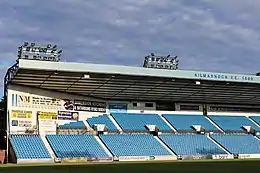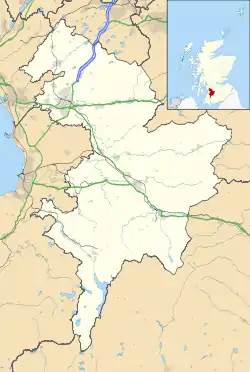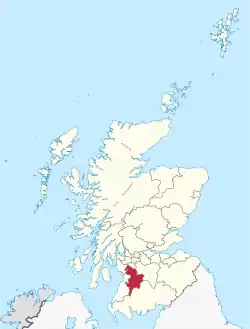Rugby Park
Rugby Park, also known as the BBSP Stadium for sponsorship reasons, is a football stadium situated in the Scottish town of Kilmarnock. It was first used in 1899 and is the home of Kilmarnock F.C.
BBSP Stadium | |
 The East Stand of Rugby Park Stadium | |
 Rugby Park Location in East Ayrshire | |
| Full name | BBSP Stadium, Rugby Park |
|---|---|
| Location | Rugby Road, Kilmarnock, East Ayrshire, Scotland |
| Coordinates | 55°36′15.21″N 4°30′29.24″W |
| Owner | Kilmarnock F.C. |
| Capacity | 17,889[1] |
| Record attendance | 35,995 v Rangers 10 March 1962 |
| Field size | 112 yd × 74 yd (102 m × 68 m) |
| Surface | Artificial – field turf |
| Construction | |
| Opened | 1 August 1899 |
| Renovated | 1946, 1961, 1994–1995 |
| Tenants | |
| 1899–present | |
It underwent a major redevelopment in 1994–1995, becoming an all-seater stadium with a capacity of 17,889.[1] In addition to its main duty of hosting home matches for Kilmarnock it has been the venue for two Scottish international matches.
It can also be used for concerts, with Elton John playing to 15,000 in a first for the venue. In 2002, the club constructed the Park Hotel, a 4-star hotel complex next to the ground.
History
Kilmarnock played at three other sites (The Grange, Holm Quarry and Ward's Park) in their early years, before the club moved to Rugby Park in December 1877.[2] This was not the precise site of the present stadium, as the field is now covered by Charles Street.[2] The grounds were shared by cricket and rugby teams – sports which Kilmarnock had played previously – and the connection with rugby gave the ground its name. Rugby Park hosted its first international match in March 1894, when Scotland won 5–2 against Wales.[2] By this time, the pitch had been moved to its current position.[2] The ground was largely rebuilt and inaugurated with a match against then-champions Celtic on 26 August 1899,[2] when Kilmarnock fought back from a 2–0 deficit to secure a draw. It was their first match in the top tier of Scottish football, having won the Second Division the previous season.
Originally, the ground was constructed with a running track around its edge, a pavilion and a stand along the west side.[2] This layout meant that Rugby Park was similar to Ibrox Park, which opened four months later.[2] The pavilion and stand were linked in 1914, which produced 1,900 seats in a total capacity of 20,000.[2] In 1935 a cover was added to part of the south terrace.[2] This terracing was later dubbed the Johnnie Walker stand, due to the company having an advert on the roof.[2] During the Second World War, the British Army installed large oil storage tanks on the pitch.[2] The club was not compensated, but Italian prisoners of war helped to extend the north terrace.[2] Floodlights were installed and first used in an October 1953 friendly match against Manchester United.[2] A roof was added to the east terrace in 1959, and the West (Main) Stand was renovated during the 1960–61 season.[2] Rugby Park set its record attendance in March 1962, when 35,995 fans saw Kilmarnock lose 4–2 to Rangers in the 1961–62 Scottish Cup.[2][3] This was a successful era for the club, as they finished runners-up in the league four times and won the league championship in 1964–65.[2]
Safety regulations cut the capacity of Rugby Park to 17,528 by the 1980s, but this figure was rarely troubled as the club fell to the Second Division.[2] The Taylor Report, published in January 1990, recommended that British stadiums should become all-seater.[2] Around the same time, a new board of directors took control of Kilmarnock.[2] The new board initially proposed to move the club to an out-of-town site besides the A77 road as part of a wider development, but this was rejected by planning restrictions.[2] The board then decided to redevelop Rugby Park. The last game before reconstruction was played on 7 May 1994, when Kilmarnock beat Rangers 1–0.[4] During the 1994–95 season the capacity was significantly reduced as three new stands were constructed; the Moffat Stand, the Chadwick Stand and the East Stand. Their completion brought the capacity of the stadium to 18,128.[4] The work was completed in just 348 days, as the new stands were first opened for a game against Rangers on 20 April.[4] Kilmarnock officially opened the new Rugby Park on 6 August 1995, in a friendly match against English league champions Blackburn Rovers. Alan Shearer hit a hat-trick as the home team lost 5–0.
On 12 May 1998 Rugby Park hosted the last Ayrshire Cup final, as Kilmarnock fought back from 0–2 to beat Ayr United 4–2. In the summer of 1999, league regulations meant that Kilmarnock had to install undersoil heating at the ground. On 26 August of that year, Kilmarnock celebrated one hundred years at Rugby Park with a victory over KR Reykjavik in the 1999–2000 UEFA Cup.
Some work has since been done to increase the revenue created by the ground. In June 2002 the Park Hotel was opened adjacent to the stadium. The hotel was built on the site of Kilmarnock's training pitch and accommodates fifty twin/double bedrooms, a conference centre, a café, bar and restaurant. In November 2004 a new sports bar was opened in the West Stand, sponsored by Foster's Lager.
An artificial playing surface was installed in the summer of 2014.[5] This was later replaced by an artificial hybrid surface during the 2019 close season.[6] In February 2019 Kilmarnock received approval to install a new safe-standing section in areas of the East and Moffat stands. The installation process was completed in early December of that year.[7]
Stadium design

Despite becoming a modern, all-seater stadium, a number of features in the design of the stands give it a unique look. All stands bar the West Stand have very little beneath them, as the tea bars and toilets are located under the lowest possible point towards the pitch. The rest of the area underneath is open tarmac, with the steel framework fully exposed. Moreover, the turnstiles for the three newer stands are built into a perimeter wall rather than the stadium itself, and there are very large open air spaces before the stands themselves. Other stadiums have a similar design – for example Tynecastle's Roseburn Stand, although there is considerable less space there. One advantage is that since the public smoking ban has come into force it has been possible for fans to stand in the open areas at half-time for a cigarette.
The East Stand is distinctive in appearance as it does not cover the full length of the pitch, tapering before ending around 15yds before the extremity of the pitch. This is because the ground behind the stand is residential, and can not be built on. However, the gap is not as large as a similar truncation at Fir Park, for example, and is filled by flags.
Disabled supporters are accommodated in an enclosures at the front of both end stands. While celebrating a late goal in a game played in August 2019, some Rangers fans caused the roof of one of these enclosures to collapse.[8]
Other uses
Rugby Union
Scotland have played two games at Rugby Park; against Tonga in November 2014 and Georgia on 26 November 2016.[9][10] The match against Tonga was the first rugby union international match featuring a tier 1 nation to be played on artificial surface.[11]
Use in film
In August 1999, Rugby Park was used for a fictitious Scottish Cup semi-final in the Robert Duvall film A Shot at Glory. The film also starred former Kilmarnock striker Ally McCoist.
Concert tours
Rugby Park has also been used as a venue concert for several musical artists.
- Singer Rod Stewart performed live at Rugby Park in 2016[12]
- Elton John performed live at Rugby Park in June 2005[13]
International matches at Rugby Park
Four Scottish international matches have been staged at Rugby Park. Normally, Scotland international matches are played at Hampden Park, but two matches were played at Rugby Park while the south stand at Hampden was being rebuilt. During the 1997 match against Wales, Kilmarnock were able to parade the Scottish Cup at half time, having captured the trophy at Ibrox on the previous Saturday.
| Scotland | 5–2 | |
|---|---|---|
| Berry Barker Chambers Alexander Johnstone |
Report | Morris Morris |
References
- "Kilmarnock Football Club". Scottish Professional Football League. Retrieved 30 September 2013.
- Inglis 1996, p. 453
- "Games Played on Sat 10 Mar 1962". www.londonhearts.com. London Hearts Supporters' Club. Retrieved 19 October 2020.
- Inglis 1996, p. 454
- "Kilmarnock to install artificial surface at Rugby Park". BBC Sport. BBC. 6 June 2014. Retrieved 7 June 2014.
- "Kilmarnock FC's new synthetic pitch features the 'best artificial turf technology' available". Daily Record. 2 August 2019. Retrieved 4 March 2020.
- "Kilmarnock U16s safe-standing section is British first". BBC Sport. BBC. 12 June 2019. Retrieved 4 March 2020.
- "Police investigate roof collapse after Rangers celebrations at Kilmarnock". BBC Sport. 4 August 2019. Retrieved 5 August 2019.
- Rugby Park to host Scotland v Tonga autumn Test, BBC Sport
- "Rugby Park confirmed as venue for Georgia Test". 8 July 2016. Retrieved 8 July 2016.
- Scotland 37–12 Tonga, BBC Sport
- "Rod Stewart review: The gravel voice is as strong as ever". dailyrecord. 19 June 2016.
- Bennett, Cath (30 June 2005). "THE RAZZ: LIVE REVIEWS: ELTON JOHN, RUGBY PARK, KILMARNOCK, JUNE 26". dailyrecord.
- Sources
- Inglis, Simon (1996). Football Grounds of Britain. Collins Willow. ISBN 0-00-218426-5.
External links
 Media related to Rugby Park at Wikimedia Commons
Media related to Rugby Park at Wikimedia Commons- Stadium Tours at Kilmarnock Football Club official website
- Rugbypark.co.uk (not associated with Kilmarnock Football Club)
- Rugby Park at KillieFC.com

